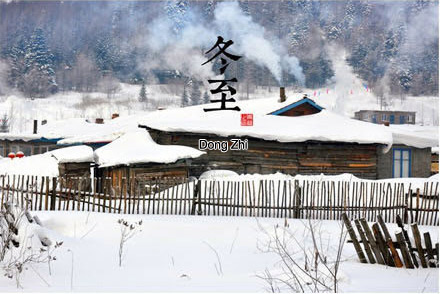The 24 solar terms: part ten-Dong Zhi

The weather in Dong Zhi enters the coldest phase. From that day on, the days become longer.
Dong Zhi: Winter Solstice
Winter Solstice is the 22nd solar term, and the most important one. Set according to astronomy, it was called “short day (ri duan)” or “the shortest day” in ancient times. On that day, the sun reaches 270 degrees longitude and shines directly on the Tropic of Capricorn. Dong Zhi comes on the fifteenth day after Da Xue. It is in the middle of the eleventh month.
On Dong Zhi, the Northern hemisphere experiences its shortest day and its longest night. From then on, the days become longer and the nights become shorter. The weather in China will also enter its coldest phase.
According to ancient records, people worshipped the gods on the day of Dong Zhi, and on the Zhou calendar, on which there were only 10 months per year, Dong Zhi was also the first day of the new year. Since the Han Dynasty (206 BC-AD 220), the lunar calendar has been used instead of the Zhou calendar, and the year was divided into 12 months. Dong Zhi became a winter festival during the Han Dynasty, and thrived during the Tang and Song dynasties (618-1279).
People believed that from this day on, as the days become longer, the yang becomes stronger and a new cycle begins. Thus, it is an auspicious day to celebrate. It was written in the Book of Jin (Jin Shu) that “Dong Zhi was celebrated by all counties and officials… The ceremony is second only to that of the Spring Festival.”
Xiao Han: Slight Cold
Xiao Han comes in the first half of January, the first half of the last month on the lunar calendar of China. It is a solar term to reflect the change in temperature, and “slight” means that though it is cold during this period, it is not yet the coldest period of winter. During Xiao Han, the sun reaches 285 degrees of longitude.
In ancient times, the period of Xiao Han was divided into three five-day periods or “hous.” The first “hou” was called “the wild goose flies back north.” The ancient Chinese believe that the wild goose migrates with the yin and yang. And as the yang begins in Xiao Han, the wild goose starts flying north.
The second “hou” was called “the magpie is nesting.” The magpies can be seen everywhere in the north. They feel the yang qi and begin to build their nests.
The third “hou” is called “the pheasant begins to tweet.” The days during Xiao Han are the coldest in winter, while the yang qi begins in this period. The pheasant feels the growth of the yang and begins to tweet.
There are some proverbs about predicting future weather according to the rain or clouds of Xiao Han, such as, “The rain in Xiao Han forecasts that the crops might be frozen to death during the Yu Shui and the Jing Zhe next year.”
